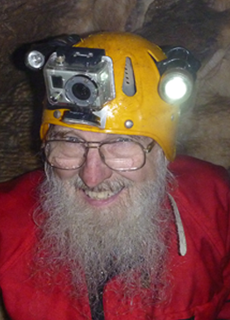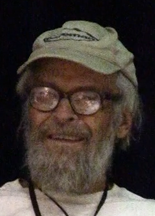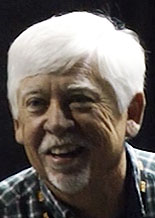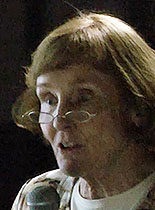2016 CONVENTION, ELY, NEVADA
FORREST WILSON
 While living in Washington, Forrest Wilson attended meetings of the D.C. Grotto, met Paul Stevens, and learned of the Organ Cave Project. Paul mentioned that Organ had a sump that “needed diving” and suggested that Forrest take a look. Using an electric light designed for coal mining, and underwater gear that seems sophomoric by today’s standards, Forrest Wilson cracked the Bowen Sump in Organ Cave. Sheck Exley read about the Bowen Sump dives in the D.C. Speleograph and invited himself up from Florida to participate. Together, Wilson and Exley found more than a mile of dry cave, thus becoming the first group in America to discover a mile of passage beyond a sump. While living in Washington, Forrest Wilson attended meetings of the D.C. Grotto, met Paul Stevens, and learned of the Organ Cave Project. Paul mentioned that Organ had a sump that “needed diving” and suggested that Forrest take a look. Using an electric light designed for coal mining, and underwater gear that seems sophomoric by today’s standards, Forrest Wilson cracked the Bowen Sump in Organ Cave. Sheck Exley read about the Bowen Sump dives in the D.C. Speleograph and invited himself up from Florida to participate. Together, Wilson and Exley found more than a mile of dry cave, thus becoming the first group in America to discover a mile of passage beyond a sump.
Possessed of an imaginative mind and a knack with tools, Forrest has developed a number of significant cave diving innovations. He constructed an early rebreather to meet the specialized problems of underwater caves. In addition, he conceived and designed a line reel that was specifically configured for cave diving. One of the features of the Wilson Reel is that its enclosed sides are transparent, so that the user could see what was going on with his inventory of dive line. Dive line is critical to finding one's way out of a cave in silt-out conditions; even more critical is knowing which direction is out. Forrest came up with a solution that has become the world standard. In recognition of his efforts, the commercial products now available have been dubbed the Wilson Line Arrow.
It is safe to say that, since the passing of Sheck Exley, Forrest Wilson has become the Senior Statesman of the American cave diving community. Download a copy (53:06, 170 MB)
DONALD DAVIS
 Donald G. Davis is a well-known authority on speleogenesis even though he has no fancy advanced degrees in the field. Instead, Donald developed his insights by reading, by careful observations while exploring, and by independent thinking while comparing what was similar and different about a wide variety of caves. Early in his caving career, Davis felt that the various theories of speleogenesis coming out of researchers working in eastern United States caves did not seem to explain all of the things that Donald was seeing out in the western United States. And, the formation mechanisms germane to some special western caves turned out to be fascinating indeed. Donald G. Davis is a well-known authority on speleogenesis even though he has no fancy advanced degrees in the field. Instead, Donald developed his insights by reading, by careful observations while exploring, and by independent thinking while comparing what was similar and different about a wide variety of caves. Early in his caving career, Davis felt that the various theories of speleogenesis coming out of researchers working in eastern United States caves did not seem to explain all of the things that Donald was seeing out in the western United States. And, the formation mechanisms germane to some special western caves turned out to be fascinating indeed.
A self-described eccentric, Donald Davis has led an interesting and somewhat nomadic life. He has worked as a beekeeper, a library aid, an importer for the British Premier carbide lamp, and as a seasonal naturalist in Badlands, in Big Bend, and in Carlsbad National Parks. Along the way, Donald made sustained, original, and lasting contributions to caving, to cave science, to spelean history, and to the NSS. He has been a leading caver in important discoveries in Groaning and associated Colorado caves, in Cave of the Winds and nearby caves, in Lilburn Cave, in the Grand Canyon backcountry, and in the Scapegoat Wilderness in Montana. Donald has racked up tens of miles of virgin passage, some in places where long caves are not the norm.
Throughout Donald Davis’ caving career, a dominant thread has been experiencing and promoting the unity of exploration and science. He views speleology as among the few remaining disciplines where individuals not funded by institutions can still make actual geographic discoveries. Download a copy (53:14, 489 MB)
Coming soon! PENNY BOSTON
2017 CONVENTION, RIO RANCHO, NEW MEXICO
DALE PATE
 For more than 20 years, Dale Pate enjoyed explo- ring and surveying in Sis- tema Purificación, and in many of the other fascina- ting caves of the Ciudad Victoria, Tamaulipas region of Mexico. For more than 20 years, Dale Pate enjoyed explo- ring and surveying in Sis- tema Purificación, and in many of the other fascina- ting caves of the Ciudad Victoria, Tamaulipas region of Mexico.
Dale Pate became the Cave Specialist for Carlsbad Caverns National Park in 1991. In this role, Pate provided coordination and oversight for all of the survey, research, and inventory activities in the park’s caves. In 2012, Pate was hired full-time as the National Cave and Karst Program Coordinator for the entire National Park Service. His many concomitant activities include preparing inventories of karst resources in the germane park units, making recommendations for important research that should be conducted, and providing education and outreach opportunities at the national level.
An expert explorer, Dale Pate is also an advocate of high-quality survey and inventory work in caves. He is skilled with the camera and many American cavers have been enthralled with his captivating photographs of the underground wilderness. Download a copy (58:27, 166 MB)
Hear Dale's award-winning cave ballad "To Turn Off the Night" here.
CAROL A. HILL
 An initial fascination with Mammoth Cave catalyzed Carol Hill’s passion for cave geology, along with the speleothems that decorate the underground world. Later, when studying a waxy mineral that she had observed in Carlsbad and in other Guadalupe caves, Carol learned that this material originated in low-pH, sulfuric-acid conditions. Subsequent sulfur isotope analysis provided additional evidence that Guadalupe caves in the Capitan Reef owed their speleogenesis to a sulfuric acid mechanism. An initial fascination with Mammoth Cave catalyzed Carol Hill’s passion for cave geology, along with the speleothems that decorate the underground world. Later, when studying a waxy mineral that she had observed in Carlsbad and in other Guadalupe caves, Carol learned that this material originated in low-pH, sulfuric-acid conditions. Subsequent sulfur isotope analysis provided additional evidence that Guadalupe caves in the Capitan Reef owed their speleogenesis to a sulfuric acid mechanism.
Carol Hill’s mineralogy studies in Mammoth and in Carlsbad provided the main impetus for her to write Cave Minerals of the World. This book is populated with fantastic color photographs of incredible minerals and speleothems. Carol has explained that one of her hopes for the Cave Minerals series is that it will stimulate scientific interest in cave mineralogy, illustrate the beauty that lies in the subterranean world, and convince even the layperson that the underground wilderness is precious and irreplaceable. Download a copy (1:06:08, 575 MB)
CHARLES H. GIBBS
 After a trip to Schoolhouse Cave, Charles Gibbs reasoned that some type of ascender activated by the legs instead of the arms would desirably free one’s hands to push off of a lip and, thus, facilitate the sometimes difficult task of topping out at the top of a pit. So, in the mid-1960s, he began development of an improved design for a climbing cam. Charles made both the cam and the shell very strong, engineered the rate of cam closure, and figured out a geometry that would prevent slippage even if the teeth were worn smooth. Because of his cautious demeanor, Gibbs emphasized safety over all other parameters when considering the variety of tradeoffs. After a trip to Schoolhouse Cave, Charles Gibbs reasoned that some type of ascender activated by the legs instead of the arms would desirably free one’s hands to push off of a lip and, thus, facilitate the sometimes difficult task of topping out at the top of a pit. So, in the mid-1960s, he began development of an improved design for a climbing cam. Charles made both the cam and the shell very strong, engineered the rate of cam closure, and figured out a geometry that would prevent slippage even if the teeth were worn smooth. Because of his cautious demeanor, Gibbs emphasized safety over all other parameters when considering the variety of tradeoffs.
In addition, Charles developed a harness design that facilitated rigging one ascender to a foot and another just above the opposite knee. In this way, the rope could be climbed in a natural “walking” manner. Over time, such an arrangement became well-known as the Ropewalker system. Download a copy (57:43, 283 MB)
|








 While living in Washington, Forrest Wilson attended meetings of the D.C. Grotto, met Paul Stevens, and learned of the Organ Cave Project. Paul mentioned that Organ had a sump that “needed diving” and suggested that Forrest take a look. Using an electric light designed for coal mining, and underwater gear that seems sophomoric by today’s standards, Forrest Wilson cracked the Bowen Sump in Organ Cave. Sheck Exley read about the Bowen Sump dives in the D.C. Speleograph and invited himself up from Florida to participate. Together, Wilson and Exley found more than a mile of dry cave, thus becoming the first group in America to discover a mile of passage beyond a sump.
While living in Washington, Forrest Wilson attended meetings of the D.C. Grotto, met Paul Stevens, and learned of the Organ Cave Project. Paul mentioned that Organ had a sump that “needed diving” and suggested that Forrest take a look. Using an electric light designed for coal mining, and underwater gear that seems sophomoric by today’s standards, Forrest Wilson cracked the Bowen Sump in Organ Cave. Sheck Exley read about the Bowen Sump dives in the D.C. Speleograph and invited himself up from Florida to participate. Together, Wilson and Exley found more than a mile of dry cave, thus becoming the first group in America to discover a mile of passage beyond a sump. 
 For more than 20 years, Dale Pate enjoyed explo- ring and surveying in Sis- tema Purificación, and in many of the other fascina- ting caves of the Ciudad Victoria, Tamaulipas region of Mexico.
For more than 20 years, Dale Pate enjoyed explo- ring and surveying in Sis- tema Purificación, and in many of the other fascina- ting caves of the Ciudad Victoria, Tamaulipas region of Mexico. An initial fascination with Mammoth Cave catalyzed Carol Hill’s passion for cave geology, along with the speleothems that decorate the underground world. Later, when studying a waxy mineral that she had observed in Carlsbad and in other Guadalupe caves, Carol learned that this material originated in low-pH, sulfuric-acid conditions. Subsequent sulfur isotope analysis provided additional evidence that Guadalupe caves in the Capitan Reef owed their speleogenesis to a sulfuric acid mechanism.
An initial fascination with Mammoth Cave catalyzed Carol Hill’s passion for cave geology, along with the speleothems that decorate the underground world. Later, when studying a waxy mineral that she had observed in Carlsbad and in other Guadalupe caves, Carol learned that this material originated in low-pH, sulfuric-acid conditions. Subsequent sulfur isotope analysis provided additional evidence that Guadalupe caves in the Capitan Reef owed their speleogenesis to a sulfuric acid mechanism. After a trip to Schoolhouse Cave, Charles Gibbs reasoned that some type of ascender activated by the legs instead of the arms would desirably free one’s hands to push off of a lip and, thus, facilitate the sometimes difficult task of topping out at the top of a pit. So, in the mid-1960s, he began development of an improved design for a climbing cam. Charles made both the cam and the shell very strong, engineered the rate of cam closure, and figured out a geometry that would prevent slippage even if the teeth were worn smooth. Because of his cautious demeanor, Gibbs emphasized safety over all other parameters when considering the variety of tradeoffs.
After a trip to Schoolhouse Cave, Charles Gibbs reasoned that some type of ascender activated by the legs instead of the arms would desirably free one’s hands to push off of a lip and, thus, facilitate the sometimes difficult task of topping out at the top of a pit. So, in the mid-1960s, he began development of an improved design for a climbing cam. Charles made both the cam and the shell very strong, engineered the rate of cam closure, and figured out a geometry that would prevent slippage even if the teeth were worn smooth. Because of his cautious demeanor, Gibbs emphasized safety over all other parameters when considering the variety of tradeoffs.